Flame Structure and Chemiluminescence Emissions of Inverse Diffusion Flames under Sinusoidally Driven Plasma Discharges
Abstract
:1. Introduction
2. Methodology
2.1. Experimental Apparatus
2.2. Chemiluminescence Measurement Systems
2.3. Test Conditions
3. Results and Discussion
3.1. Electrical Characterization of the Plasma Discharge
3.2. Visible Appearance of Flame at Different Fueling Mass Flow Rates in Absence of Plasma Actuation
3.3. Visible Flame Morphology and Structure: Effect of DBD Plasma Actuator on the IDF Flame
3.4. CCD Imaging Chemiluminescence
4. Conclusions
Acknowledgments
Author Contributions
Conflicts of Interest
References
- Oh, J.; Noh, D. Flame characteristics of a non-premixed oxy-fuel jet in a lab-scale furnace. Energy 2015, 81, 328–343. [Google Scholar] [CrossRef]
- Lee, S.; Padilla, R.; Dunn-Rankin, D.; Pham, T.; Kwon, O.C. Extinction limits and structure of counterflow nonpremixed H2O-laden CH4/air flames. Energy 2015, 93, 442–450. [Google Scholar] [CrossRef]
- Gao, X.; Duan, F.; Lim, S.C.; Yip, M.S. NOx formation in hydrogen–methane turbulent diffusion flame under the moderate or intense low-oxygen dilution conditions. Energy 2013, 59, 559–569. [Google Scholar] [CrossRef]
- De Giorgi, M.G.; Sciolti, A.; Campilongo, S.; Ficarella, A. Assessment of the Combustion Behaviour of a Pilot-Scale Gas Turbine Burner Using Image Processing. In Proceedings of the ASME 2014 Power Conference, Baltimore, MD, USA, 28–31 July 2014.
- De Giorgi, M.G.; Sciolti, A.; Campilongo, S.; Ficarella, A. Image processing for the characterization of flame stability in a non-premixed liquid fuel burner near lean blowout. Aerosp. Sci. Technol. 2016, 49, 41–51. [Google Scholar] [CrossRef]
- De Giorgi, M.G.; Sciolti, A.; Campilongo, S.; Ficarella, A. Experimental data regarding the characterization of the flame behaviour near lean blowout in a non-premixed liquid fuel burner. Data Brief 2016, 6, 189–193. [Google Scholar] [CrossRef] [PubMed]
- Baigmohammadi, M.; Tabejamaat, S.; Zarvandi, J. Numerical study of the behavior of methane-hydrogen/air pre-mixed flame in a micro reactor equipped with catalytic segmented bluff body. Energy 2015, 85, 117–144. [Google Scholar] [CrossRef]
- Sze, L.K.; Cheung, C.S.; Leung, C.W. Appearance, temperature, and NOx emission of two inverse diffusion flames with different port design. Combust. Flame 2006, 144, 237–248. [Google Scholar] [CrossRef]
- Shaddix, C.R.; Williams, T.C.; Blevins, L.G.; Schefer, R.W. Flame structure of steady and pulsed sooting inverse jet diffusion flames. Proc. Combust. Inst. 2005, 30, 1501–1508. [Google Scholar] [CrossRef]
- Stansel, D.M.; Laurendeau, N.M.; Senser, D.W. CO and NOx emissions from a controlled-air burner: Experimental measurements and exhaust correlations. Combust. Sci. Technol. 1995, 104, 207–234. [Google Scholar] [CrossRef]
- Mahesh, S.; Mishra, D.P. Flame stability and emission characteristics of turbulent LPG IDF in a backstep burner. Fuel 2008, 87, 2614–2619. [Google Scholar] [CrossRef]
- Hwang, S.S.; Gore, J.P. Combustion and radiation characteristics of oxygen-enhanced inverse diffusion flame. KSME Int. J. 2002, 1156–1165. [Google Scholar] [CrossRef]
- Dong, L.L.; Cheung, C.S.; Leung, C.W. Combustion optimization of a port-array inverse diffusion flame jet. Energy 2011, 36, 2834–2846. [Google Scholar] [CrossRef]
- Dong, L.L.; Cheung, C.S.; Leung, C.W. Heat transfer optimization of an impinging port-array inverse diffusion flame jet. Energy 2013, 49, 182–192. [Google Scholar] [CrossRef]
- Sidebotham, G.W.; Glassman, I. Flame temperature, fuel structure, and fuel concentration effects on soot formation in inverse diffusion flames. Combust. Flame 1992, 90, 273–283. [Google Scholar] [CrossRef]
- Choi, S.; Kim, T.Y.; Kim, H.K.; Koo, J.; Kim, J.S.; Kwon, O.C. Properties of inverse non premixed pure O2/CH4 coflow flames in a model combustor. Energy 2015, 93, 1105–1115. [Google Scholar] [CrossRef]
- Song, X.; Gong, Y.; Yu, G.; Guo, Q.; Dai, Z. Chemiluminescence Studies of Coke Oven Gas/O2 Coflow Normal/Inverse Diffusion Flames. J. Eng. Gas Turbines Power 2015, 137, 081505. [Google Scholar] [CrossRef]
- De Giorgi, M.G.; Sciolti, A.; Ficarella, A. Application and Comparison of Different Combustion Models of High Pressure LOX/CH4 Jet Flames. Energies 2014, 7, 477–497. [Google Scholar] [CrossRef]
- De Giorgi, M.G.; Sciolti, A.; Ficarella, A. Spray and Combustion Modeling in High Pressure Cryogenic Jet Flames. In Proceedings of the ASME Turbo Expo 2012: Turbine Technical Conference and Exposition, Volume 2: Combustion, Fuels and Emissions, Parts A and B, Copenhagen, Denmark, 11–15 June 2012; pp. 1161–1176.
- De Giorgi, M.G.; Sciolti, A.; Ficarella, A. Comparisons between different combustion models for High pressure LOX/CH4 jet flames. In Proceedings of the 41st AIAA Fluid Dynamics Conference and Exhibit, Honolulu, HI, USA, 27–30 June 2011.
- De Giorgi, M.G.; Tarantino, L.; Ficarella, A.; Laforgia, D. Numerical Modelling of High-Pressure Cryogenic Sprays. In Proceedings of the 40th Fluid Dynamics Conference and Exhibit, Chicago, IL, USA, 28 June–1 July 2010.
- Schumaker, S.A.; Driscoll, J.F. Coaxial turbulent jet flames: Scaling relations for measured stoichiometric mixing lengths. Proc. Combust. Inst. 2009, 32, 1655–1662. [Google Scholar] [CrossRef]
- De Giorgi, M.G.; Sciolti, A.; Campilongo, S.; Pescini, E.; Ficarella, A.; Martini, L.M.; Tosi, P.; Dilecce, G. Plasma Assisted Flame Stabilization in a Non-Premixed Lean Burner. Energy Procedia 2015, 82, 410–416. [Google Scholar] [CrossRef]
- De Giorgi, M.G.; Sciolti, A.; Campilongo, S.; Pescini, E.; Ficarella, A.; Martini, L.M.; Tosi, P.; Lovascio, S.; Dilecce, G. Lean Blowout Sensing and Plasma Actuation of Non-Premixed Flames. IEEE Sens. J. 2016, 16, 3896–3903. [Google Scholar] [CrossRef]
- Klimov, A.; Bityurin, V.; Kuznetsov, A.; Tolkunov, B.; Vystavkin, N.; Vasiliev, M. External and Internal Plasma-Assisted Combustion. In Proceedings of the 42nd AIAA Aerospace Sciences Meeting and Exhibit, Reno, NV, USA, 4–8 January 2004.
- Bao, A.; Utkin, Y.G.; Keshav, S.; Lou, G.; Adamovich, I.V. Ignition of ethylene-air and methane-air flows by low-temperature repetitively pulsed nanosecond discharge plasma. IEEE Trans. Plasma Sci. 2007, 35, 1628–1638. [Google Scholar] [CrossRef]
- Won, S.H.; Cha, M.S.; Park, C.S.; Chung, S.H. Effect of electric fields on reattachment and propagation speed of tribrachial flames in laminar coflow jets. Proc. Combust. Inst. 2007, 31, 963–970. [Google Scholar] [CrossRef]
- Pilla, G.; Galley, D.; Lacoste, D.A.; Lacas, F.; Veynante, D.; Laux, C.O. Stabilization of a turbulent premixed flame using a nanosecond repetitively pulsed plasma. IEEE Trans. Plasma Sci. 2006, 34, 2471–2477. [Google Scholar] [CrossRef]
- Ombrello, T.; Qin, X.; Ju, Y.; Gutsol, A.; Fridman, A.; Carter, C. Combustion Enhancement via Stabilized Piecewise Nonequilibrium Gliding Arc Plasma Discharge. AIAA J. 2006, 44, 142–150. [Google Scholar] [CrossRef]
- Kim, W.; Do, H.; Mungal, M.G.; Cappelli, M.A. Plasma-Discharge Stabilization of Jet Diffusion Flames. IEEE Trans. Plasma Sci. 2006, 34, 2545–2551. [Google Scholar] [CrossRef]
- Pescini, E.; De Giorgi, M.G.; Francioso, L.; Sciolti, A.; Ficarella, A. Effect of a micro dielectric barrier discharge plasma actuator on quiescent flow. IET Sci. Meas. Technol. 2014, 8, 135–142. [Google Scholar] [CrossRef]
- Anikin, N.; Kukaev, E.; Starikovskaia, S.; Starikovskii, A. Ignition of hydrogen-air and methane-air mixtures at low temperatures by nanosecond high voltage discharge. In Proceedings of the 42nd AIAA Aerospace Sciences Meeting and Exhibit, Reno, NV, USA, 4–8 January 2004.
- Starikovskaia, S.M. Plasma assisted ignition and combustion. J. Phys. D Appl. Phys. 2006, 39, R265–R299. [Google Scholar] [CrossRef]
- Pham, Q.L.L.; Lacoste, D.A.; Laux, C.O. Stabilization of a Premixed Methane–Air Flame Using Nanosecond Repetitively Pulsed Discharges. IEEE Trans. Plasma Sci. 2011, 39, 2264–2265. [Google Scholar] [CrossRef]
- Choi, W.; Neumeier, Y.; Jagoda, J. Stabilization of a Combustion Process near Lean Blow Off by an Electric Discharge. In Proceedings of the 42nd AIAA Aerospace Sciences Meeting and Exhibit, Reno, NV, USA, 4–8 January 2004.
- Pescini, E.; Martínez, D.S.; De Giorgi, M.G.; Ficarella, A. Optimization of micro single dielectric barrier discharge plasma actuator models based on experimental velocity and body force fields. Acta Astronaut. 2015, 116, 318–332. [Google Scholar] [CrossRef]
- Pescini, E.; Marra, F.; De Giorgi, M.G.; Francioso, L.; Ficarella, A. Investigation of the boundary layer characteristics for assessing the DBD plasma actuator control of the separated flow at low Reynolds numbers. Exp. Therm. Fluid Sci. 2017, 81, 482–498. [Google Scholar] [CrossRef]
- Tang, J.; Zhao, W.; Duan, Y. In-depth study on propane–air combustion enhancement with dielectric barrier discharge. IEEE Trans. Plasma Sci. 2010, 38, 3272–3281. [Google Scholar] [CrossRef]
- Im, S.K.; Bak, M.S.; Mungal, M.G.; Cappelli, M.A. Plasma Actuator Control of a Lifted Ethane Turbulent Jet Diffusion Flame. IEEE Trans. Plasma Sci. 2013, 41, 3293–3298. [Google Scholar] [CrossRef]
- Matsubara, Y.; Takita, K.; Masuya, G. Combustion enhancement in a supersonic flow by simultaneous operation of DBD and plasma jet. Proc. Combust. Inst. 2013, 34, 3287–3294. [Google Scholar] [CrossRef]
- Criner, K.; Cessou, A.; Louiche, J.; Vervisch, P. Stabilization of turbulent lifted jet flames assisted by pulsed high voltage discharge. Combust. Flame 2006, 144, 422–425. [Google Scholar] [CrossRef]
- Festo Flowmeter Specifications. Available online: http://www.festo.com/net/fi_fi/SupportPortal/default.aspx?cat=1959&q=SFAB&tab=3&type=92 (accessed on 10 November 2015).
- Cole Parmer Flow Meters. Available online: https://www.coleparmer.com/i/mn/3290757 (accessed on 10 November 2015).
- Dielectric Barrier Corona and Plasma Discharge Resonant Driver by Information Unlimited®. Available online: http://www.amazing1.com/products/dielectric-barrier-corona-and-plasma-discharge-resonant-driver.html (accessed on 10 November 2015).
- Tektronix P6015A Specifications. Available online: http://uk.tek.com/datasheet/high-voltage-probe-single-ended/p5100a-tpp0850-p5122-p5150-p6015a-datasheet-0 (accessed on 10 November 2015).
- Bergoz Current Transformer CT-C1.0-B Specifications. Available online: http://www.gmw.com/electric_current/Bergoz/documents/CT.11flyer.PDF (accessed on 10 November 2015).
- Tektronix TDS2024C Specifications. Available online: http://www.testequipmentdepot.com/tektronix/oscilloscope/tds2024c.htm (accessed on 10 November 2015).
- Memrecam® User’s Manual. Available online: http://www.nacinc.com/datasheets/archive/Memrecam_GX-3.pdf (accessed on 10 November 2015).
- La Vision ICCD User’s Manual. Available online: http://www.lavision.de/en/products/cameras/iccd_cameras.php (accessed on 10 November 2015).
- High-Speed Intensified Camera Specifications. Available online: http://www.lambertinstruments.com/hicatt (accessed on 10 November 2015).
- NI-USB 6008 User’s Manual. Available online: http://sine.ni.com/nips/cds/view/p/lang/it/nid/201986 (accessed on 10 November 2015).
- Moffat, R.J. Describing the uncertainties in experimental results. Exp. Therm. Fluid Sci. 1988, 1, 3–17. [Google Scholar] [CrossRef]
- Mahesh, S.; Mishra, D.P. Dynamic sensing of blowout in turbulent CNG inverse jet flame. Combust. Flame 2015, 162, 3046–3052. [Google Scholar] [CrossRef]
- Mikofski, M.A.; Williams, T.C.; Shaddix, C.R.; Blevins, L.G. Flame height measurement of laminar inverse diffusion flames. Combust. Flame 2006, 146, 63–72. [Google Scholar] [CrossRef]
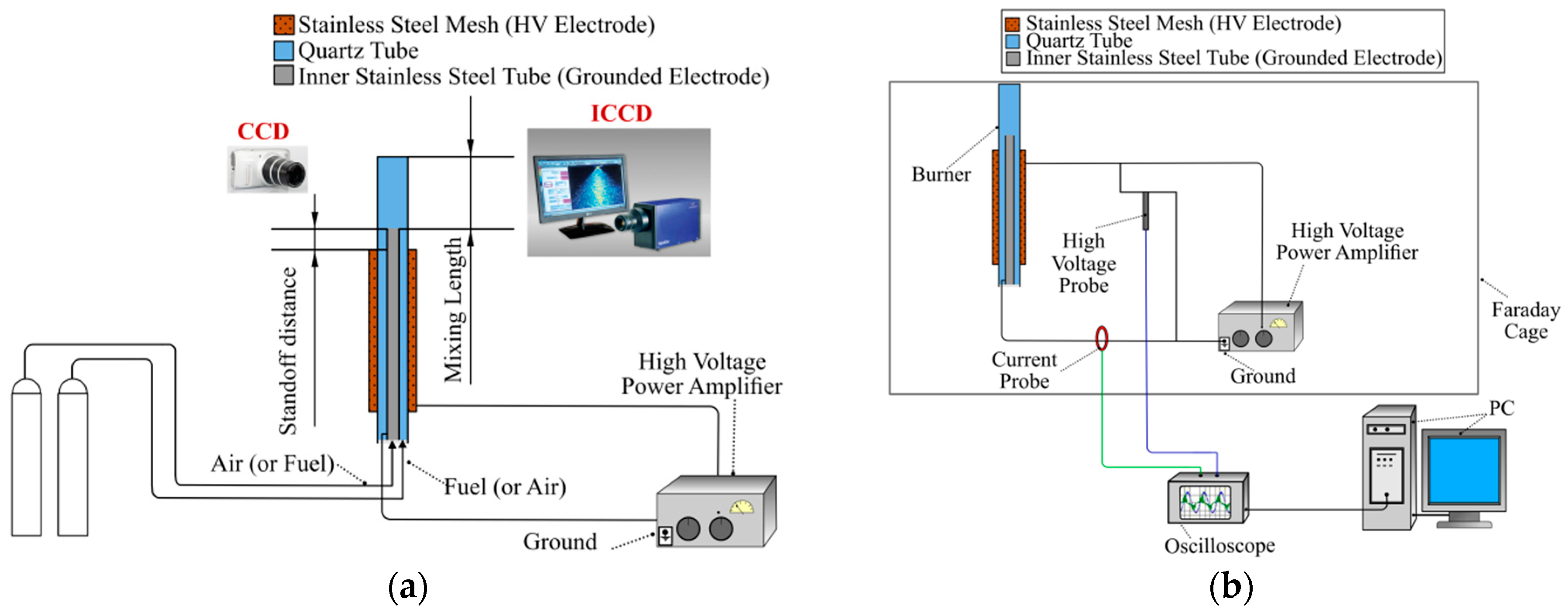
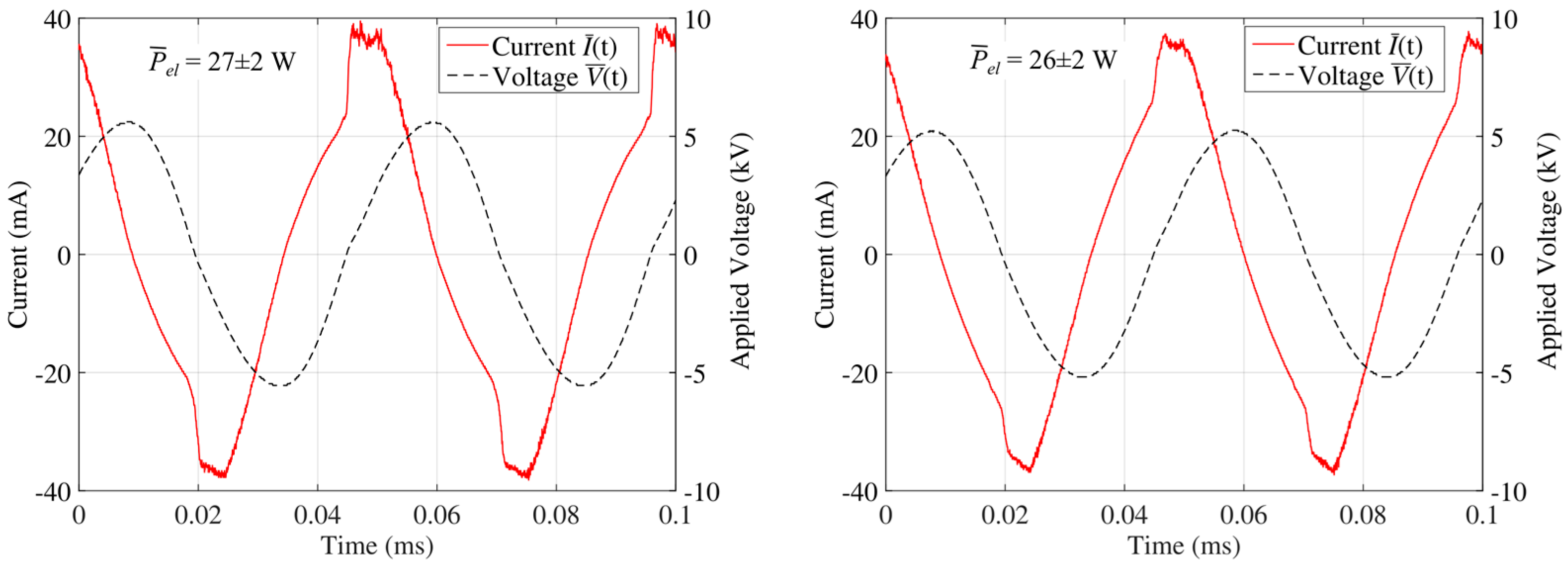

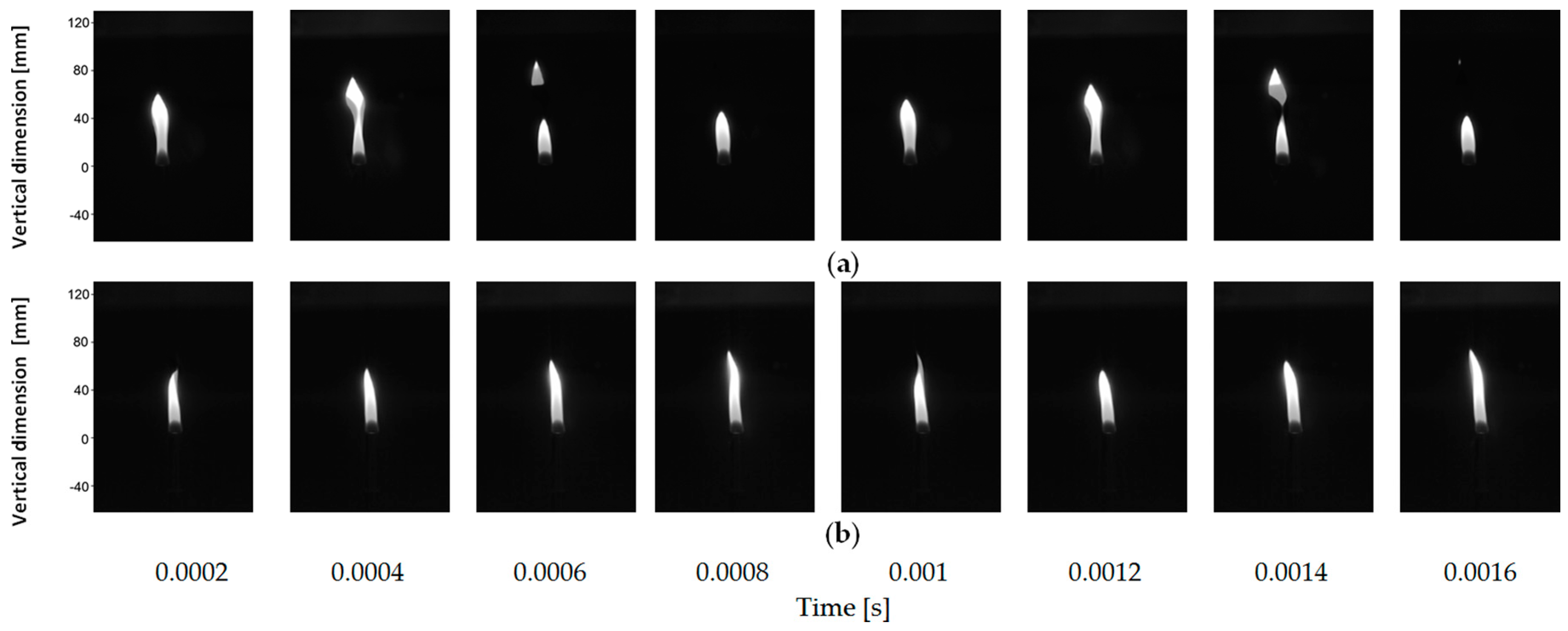

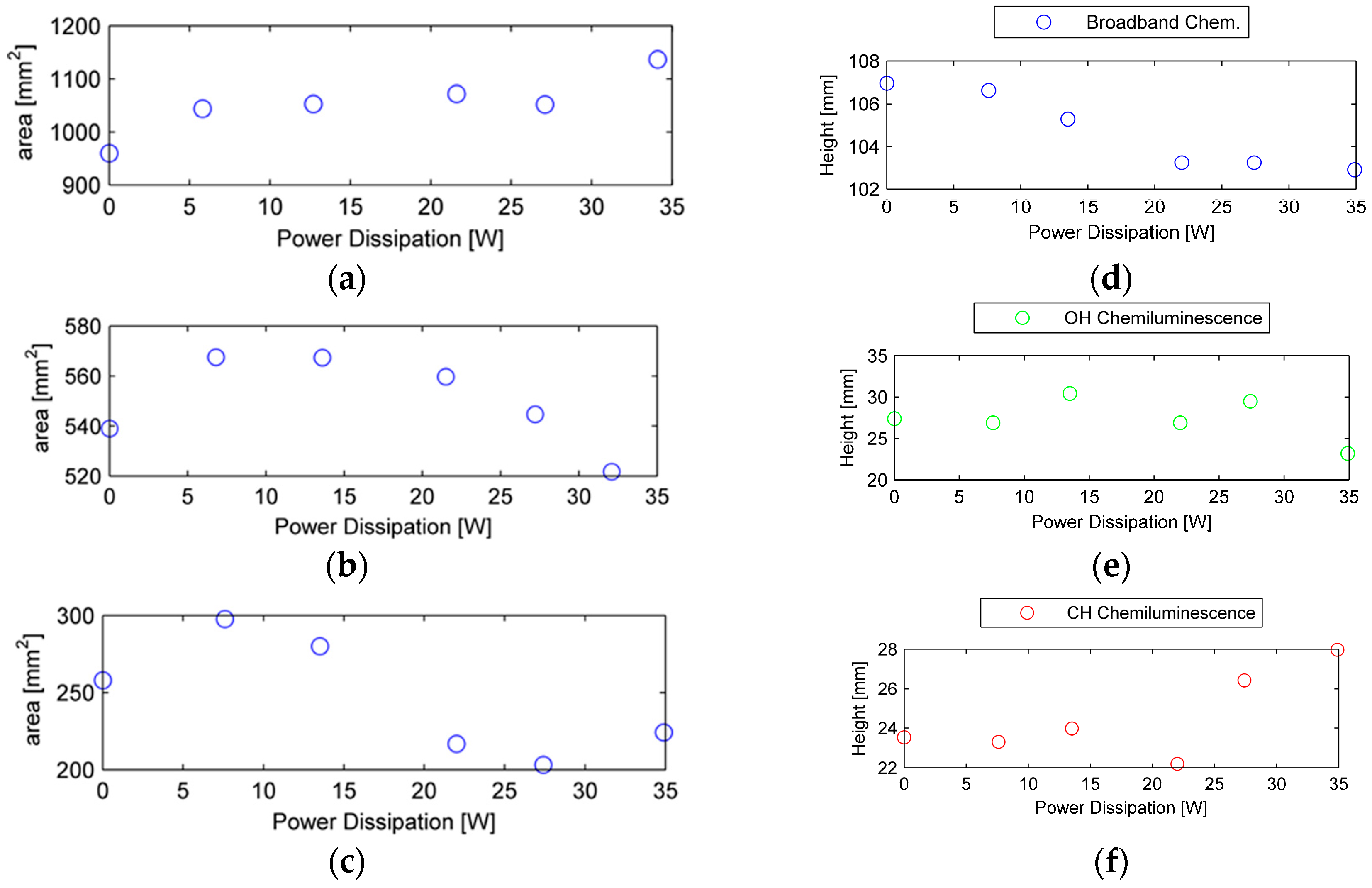

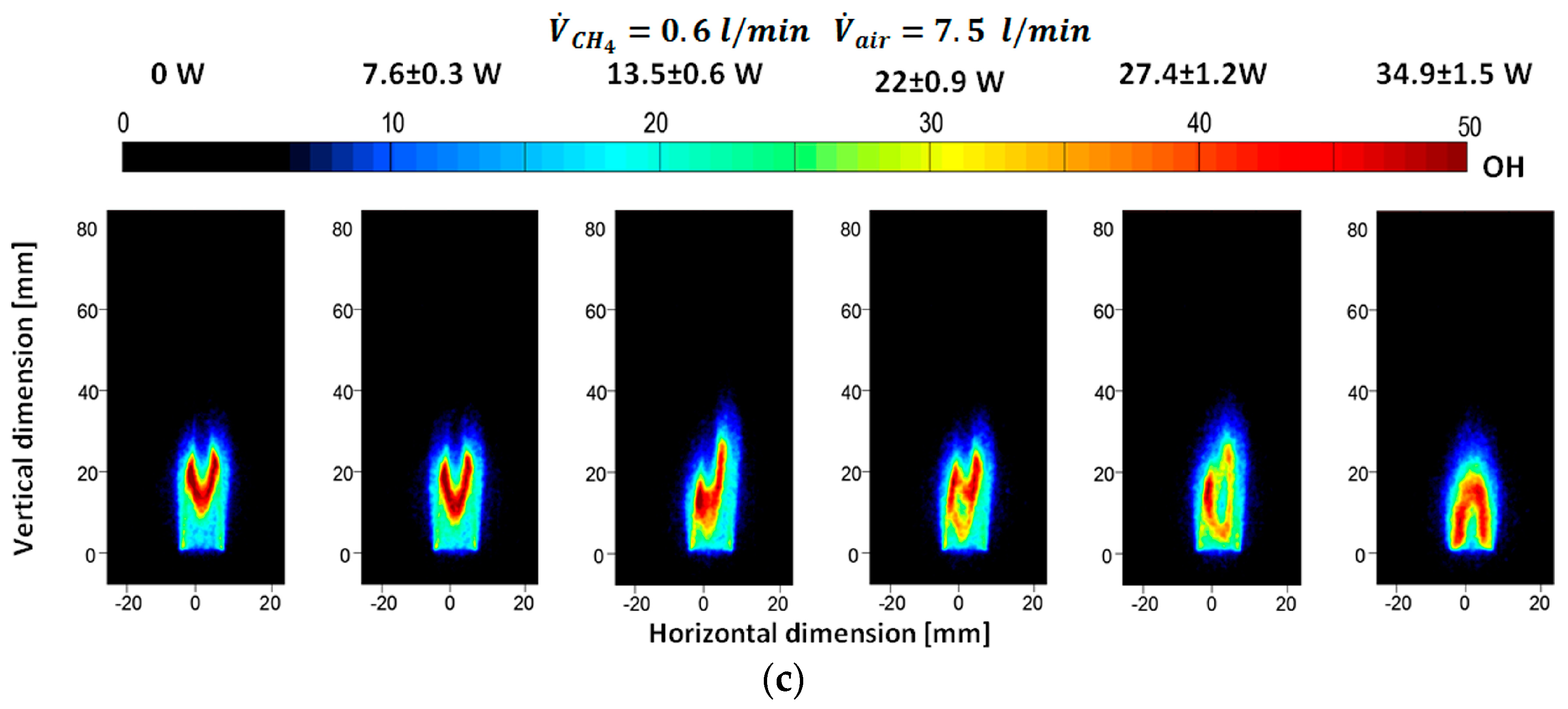
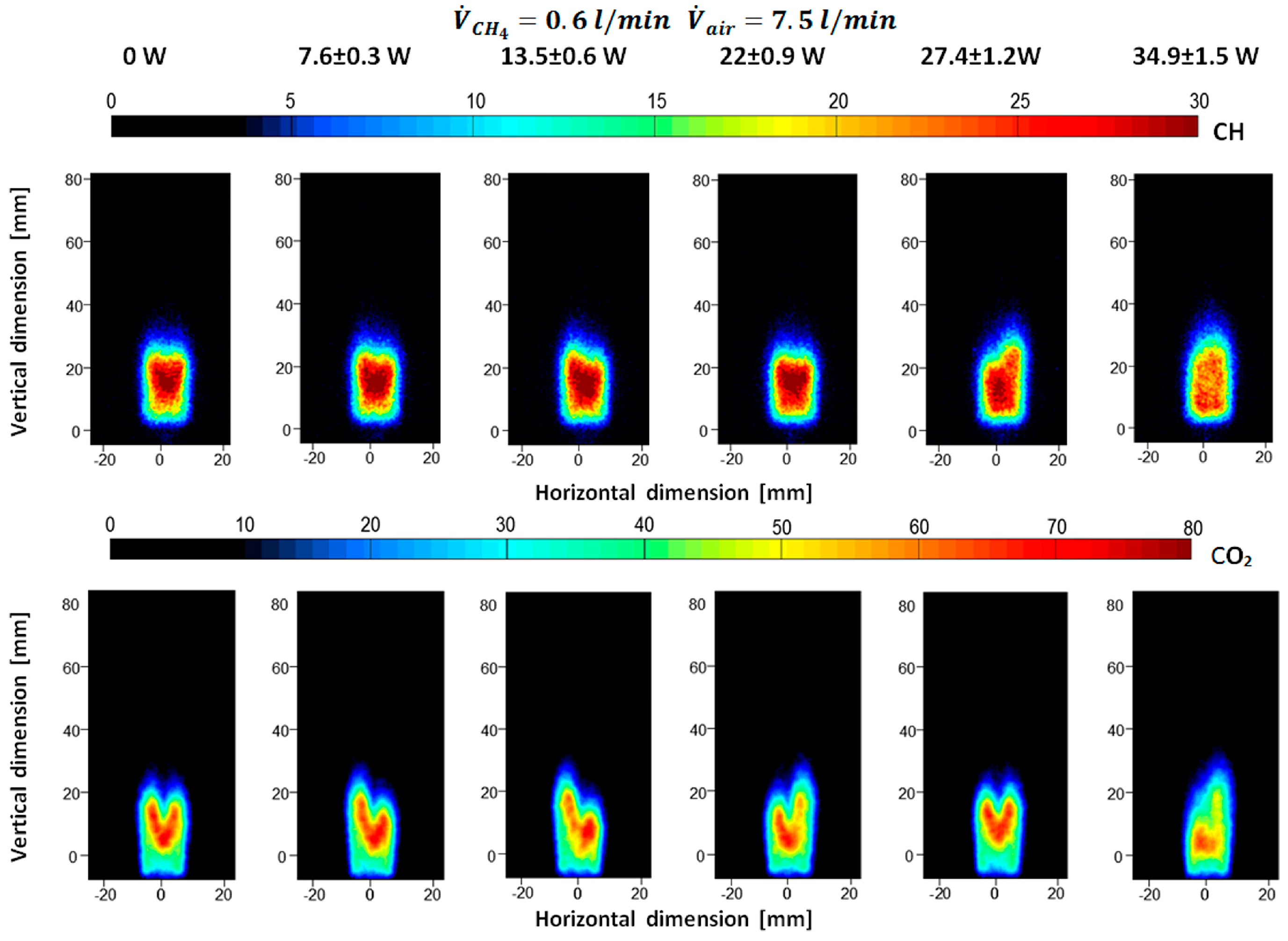

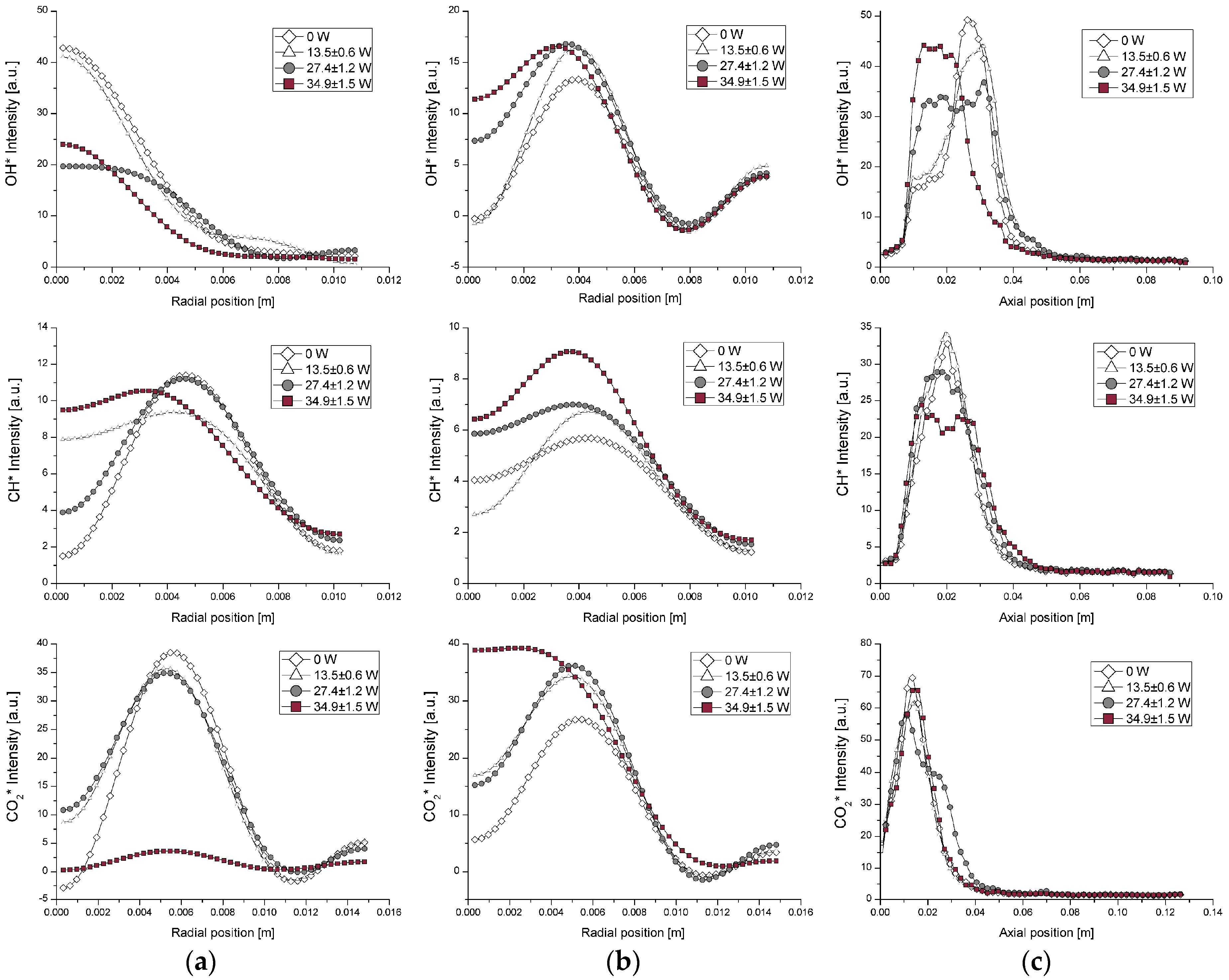
| (L/min) | air (L/min) | (m/s) | (m/s) | (O/F)mom | ||
|---|---|---|---|---|---|---|
| 0.6 | 3.5 | 0.35 | 1.52 | 63.31 | 714.52 | 34.30 |
| 0.6 | 7.5 | 0.35 | 3.25 | 63.31 | 1531.12 | 157.49 |
| 0.6 | 0 | 1.52 | 0 | 63.31 | 0 | 0 |
| CH4 (L/min) | Air (L/min) | Peak-to-Peak Voltage (kV) | Power Dissipation (W) |
|---|---|---|---|
| 0.6 | 3.5 | 0 | 0 |
| 8.7 ± 0.3 | 6.8 ± 0.3 | ||
| 9 ± 0.3 | 13.6 ± 0.6 | ||
| 9.7 ± 0.3 | 21.5 ± 0.9 | ||
| 10.4 ± 0.3 | 27.2 ± 1.1 | ||
| 10.9 ± 0.3 | 32.1 ± 1.4 | ||
| 7.5 | 0 | 0 | |
| 8.8 ± 0.3 | 7.6 ± 0.3 | ||
| 9.5 ± 0.3 | 13.5 ± 0.6 | ||
| 10.5 ± 0.3 | 22 ± 0.9 | ||
| 11.2 ± 0.3 | 27.4 ± 1.2 | ||
| 12.1 ± 0.4 | 34.9 ± 1.5 | ||
| 0 | 0 | 0 | |
| 7.5 ± 0.2 | 5.8 ± 0.2 | ||
| 9.1 ± 0.3 | 12.7 ± 0.5 | ||
| 10.2 ± 0.3 | 21.6 ± 0.9 | ||
| 10.7 ± 0.3 | 27.1 ± 1.1 | ||
| 11.6 ± 0.3 | 34.1 ± 1.4 |
© 2017 by the authors. Licensee MDPI, Basel, Switzerland. This article is an open access article distributed under the terms and conditions of the Creative Commons Attribution (CC BY) license ( http://creativecommons.org/licenses/by/4.0/).
Share and Cite
De Giorgi, M.G.; Sciolti, A.; Campilongo, S.; Ficarella, A. Flame Structure and Chemiluminescence Emissions of Inverse Diffusion Flames under Sinusoidally Driven Plasma Discharges. Energies 2017, 10, 334. https://doi.org/10.3390/en10030334
De Giorgi MG, Sciolti A, Campilongo S, Ficarella A. Flame Structure and Chemiluminescence Emissions of Inverse Diffusion Flames under Sinusoidally Driven Plasma Discharges. Energies. 2017; 10(3):334. https://doi.org/10.3390/en10030334
Chicago/Turabian StyleDe Giorgi, Maria Grazia, Aldebara Sciolti, Stefano Campilongo, and Antonio Ficarella. 2017. "Flame Structure and Chemiluminescence Emissions of Inverse Diffusion Flames under Sinusoidally Driven Plasma Discharges" Energies 10, no. 3: 334. https://doi.org/10.3390/en10030334






